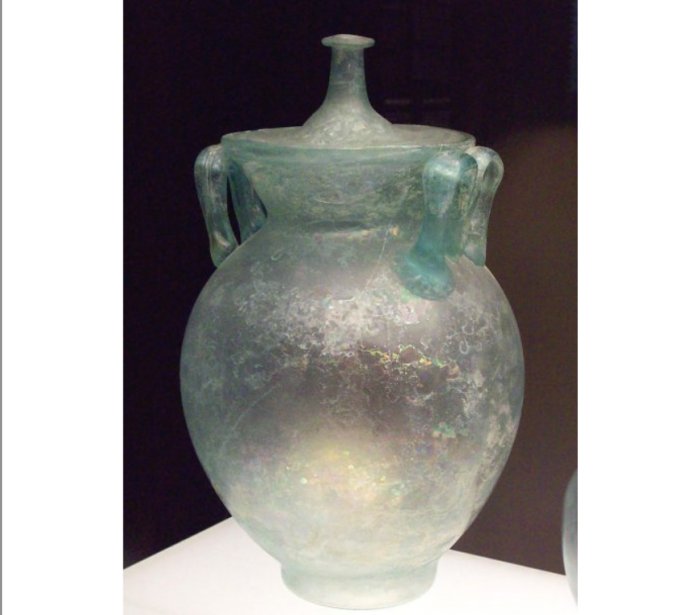Flexible Glass – Lost Ancient Roman Invention Because Glassmaker Was Beheaded By Emperor Tiberius
Ellen Lloyd - AncientPages.com - Did ancient Romans invent unbreakable glass? If they did, their secrets would be long lost because the Roman Emperor Tiberius beheaded the inventor of flexible glass.
A Roman blown-glass cinerary urn, dated between 1st and 3rd centuries AD. Image credit: Luis García - CC BY-SA 3.0
According to Roman authors Petronius (c. 27–66 AD) and Pliny the Elder (23–79 AD), a glassmaker was granted an audience with Emperor Tiberius. The glassmaker presented an incredible invention called a phiale (a shallow drinking vessel). The drinking bowl must have been made out of extraordinary material because he failed when the Roman Emperor Tiberius Caesar attempted to break the bowl.
Instead of breaking, the bowl dented like a bronze vessel. The glassmaker took out a hammer and removed the dent.
When Emperor Tiberius asked if anyone else knew how to make this kind of glass, the proud inventor replied that he knew the manufacturing technique. Unfortunately, the Emperor was by no means impressed.
Emperor Tiberius feared that such remarkable material could undermine the value of gold and silver and gave the order to behead the inventor.
In his Naturalis Historia, Pliny the Elder relates the story, but he also clarifies that he doesn’t believe anyone invented flexible glass (vitrum flexile). According to Pliny, the Elder, it’s just a story.
Another version of the story is told by Dio Cassius (AD 150–235), a Roman statesman and historian of Greek origin. Dio Cassius wrote in his Historia Romana that ‘an architect whose name no one knows’ aroused the jealousy of Emperor Tiberius, who exiled him. Emperor Tiberius was jealous of the architect’s skills.
Portrait of Roman Emperor Tiberius in Ny Carlsberg Glyptotek, Copenhagen. Original. Cast in Rome. Image credit: Cnyborg - Public Domain
“About this time, one of the largest porticos in Rome began to lean to one side and was set upright in a remarkable way by an architect whose name no one knows because Tiberius, jealous of his wonderful achievement, would not permit it to be entered in the records. This architect, then, whatever his name may have been, first strengthened the foundations roundabout so that they should not collapse, and wrapped all the rest of the structure in fleeces and thick garments, binding it firmly together on all sides by means of ropes; then with the aid of many men and windlasses, he raised it back to its original position.
At the time, Tiberius both admired and envied him; for the former reason, he honored him with a present of money, and for the latter, he expelled him from the city. Later the exile approached him to crave pardon, and while doing so, he purposely let a crystal goblet fall; and though it was bruised in some way or shattered, he promptly exhibited it whole once more by passing his hands over it. He hoped to obtain pardon for this, but instead, the Emperor put him to death.” (Historia Romana 57.21.7).
Whether the story is just a myth or there is some truth behind it, it is impossible to say. No example of Roman vitreum flexible is known to exist.
Could a Roman inventor have invented a form of break-resistant, denting glass? Modern scientists are attempting to develop flexible glass that will be used in smartphones.
It is important to remember that Roman glassmaking peaked during the early Imperial period, around the 1st century AD.
 The map depicts the Roman Empire in 117 C.E., at the height of the Pax Romana. (background) Image credit: ushistory.org
The map depicts the Roman Empire in 117 C.E., at the height of the Pax Romana. (background) Image credit: ushistory.org
The Pax Romana (‘Roman Peace’) was a period of relative peace and stability across the Roman Empire that lasted for over 200 years, beginning with the reign of Augustus (27 BC – 14 CE), the first emperor of Rome to the rule of Marcus Aurelius (161 -180 CE).
During this period, there were constant improvements in glassmaking techniques. It was also a time when glassblowing was invented. It was quicker and required fewer resources per vessel than earlier methods. Ancient Romans started to produce colorless glass, window panes, and glass mosaics. Historians say Roman glassmaking was so advanced that some achievements could only be replicated in the 18th century.
An inventor could have successfully produced flexible glass, but he made a mistake in showing the Emperor his achievement.
There are several examples of ancient Roman inventions that changed the world. Ancient Romans were skilled inventors who were not afraid of experimenting with technology. As a result of their efforts, we can today benefit from various surgical tools, bound books, aqueducts, and many other things we take for granted.
Written by Ellen Lloyd – AncientPages.com
Updated on July 26, 2023
Copyright © AncientPages.com All rights reserved. This material may not be published, broadcast, rewritten or redistributed in whole or part without the express written permission of AncientPages.com
Expand for referencesRoman Mold-blown Glass: The First Through Sixth Centuries
By E. M. Stern, Toledo Museum of Art
Isidore of Seville (2006). The Etymologies
More From Ancient Pages
-
 Humans’ Oldest Jawed Ancestor Is A 439-Million-Year-Old Spiky Shark – Surprising Discovery Shows
Archaeology | Sep 29, 2022
Humans’ Oldest Jawed Ancestor Is A 439-Million-Year-Old Spiky Shark – Surprising Discovery Shows
Archaeology | Sep 29, 2022 -
 Unknown Fragments Of Two Euripides Tragedies Found In Egyptian Grave
Scripts, Paintings & Inscriptions | Sep 9, 2024
Unknown Fragments Of Two Euripides Tragedies Found In Egyptian Grave
Scripts, Paintings & Inscriptions | Sep 9, 2024 -
 Plutonium: Dangerous Pluto’s Gate Was An Ancient Gateway To Hell At Hierapolis That Was Real
Featured Stories | Feb 18, 2017
Plutonium: Dangerous Pluto’s Gate Was An Ancient Gateway To Hell At Hierapolis That Was Real
Featured Stories | Feb 18, 2017 -
 Riddle Of An Ancient Underground City No-One Thinks Exist – Have We Misunderstood Plato? Part 1
Ancient Mysteries | Sep 16, 2019
Riddle Of An Ancient Underground City No-One Thinks Exist – Have We Misunderstood Plato? Part 1
Ancient Mysteries | Sep 16, 2019 -
 Creepy And Unusual Ancient Skull Found In Small Crypt Investigated By Scientists But Can They Solve The Mystery?
Ancient Mysteries | Feb 2, 2025
Creepy And Unusual Ancient Skull Found In Small Crypt Investigated By Scientists But Can They Solve The Mystery?
Ancient Mysteries | Feb 2, 2025 -
 Mysterious Abaj Takalik Of Guatemala And Intriguing Relationship Between Olmec and Maya
Civilizations | Mar 16, 2020
Mysterious Abaj Takalik Of Guatemala And Intriguing Relationship Between Olmec and Maya
Civilizations | Mar 16, 2020 -
 Egyptian Royal Artifacts Found At ‘Ancient Buto’ Site, Egypt Probably Dated To King Psamtik I’s Reign
Archaeology | Jan 4, 2018
Egyptian Royal Artifacts Found At ‘Ancient Buto’ Site, Egypt Probably Dated To King Psamtik I’s Reign
Archaeology | Jan 4, 2018 -
 Mysterious Tiahuanaco Empire Established By The Sons Of The Sun – An Unknown Chapter Of Prehistory
Ancient Mysteries | Oct 30, 2018
Mysterious Tiahuanaco Empire Established By The Sons Of The Sun – An Unknown Chapter Of Prehistory
Ancient Mysteries | Oct 30, 2018 -
 Anchor Church Caves – Has The Home Of Anglo-Saxon King Eardwulf And Saint Hardulph Been Found?
Archaeology | Jul 23, 2021
Anchor Church Caves – Has The Home Of Anglo-Saxon King Eardwulf And Saint Hardulph Been Found?
Archaeology | Jul 23, 2021 -
 Brihadeshwara Temple – Outstanding Example Of Chola Architecture In Tamil Nadu, India
Featured Stories | Aug 26, 2021
Brihadeshwara Temple – Outstanding Example Of Chola Architecture In Tamil Nadu, India
Featured Stories | Aug 26, 2021 -
 Strange And Unexplained Events In Transylvania – One Of The Most Mysterious Places In Europe
Featured Stories | Jan 6, 2022
Strange And Unexplained Events In Transylvania – One Of The Most Mysterious Places In Europe
Featured Stories | Jan 6, 2022 -
 Kingdom Of Nubia: Pyramids And Priceless Secrets Of A Civilization Forgotten Long Time Ago
Civilizations | Feb 13, 2018
Kingdom Of Nubia: Pyramids And Priceless Secrets Of A Civilization Forgotten Long Time Ago
Civilizations | Feb 13, 2018 -
 Mayong – Mysterious Ancient Land Of Black Magic In India
Featured Stories | Mar 7, 2019
Mayong – Mysterious Ancient Land Of Black Magic In India
Featured Stories | Mar 7, 2019 -
 Why Were Wampum Belts Important To Native Americans?
Featured Stories | May 10, 2018
Why Were Wampum Belts Important To Native Americans?
Featured Stories | May 10, 2018 -
 Neanderthals May Have Been Carnivores – New Study
Archaeology | Oct 17, 2022
Neanderthals May Have Been Carnivores – New Study
Archaeology | Oct 17, 2022 -
 Norse God Tyr Who Gave Viking Warriors Courage And Self-Confidence In Battle
Featured Stories | Mar 7, 2018
Norse God Tyr Who Gave Viking Warriors Courage And Self-Confidence In Battle
Featured Stories | Mar 7, 2018 -
 Orthodox Church In Black Sea Region Looted By Treasure Hunters
Archaeology | Feb 24, 2021
Orthodox Church In Black Sea Region Looted By Treasure Hunters
Archaeology | Feb 24, 2021 -
 Secrets Of Mysterious Bronze Age Hoard Found In Rosemarkie, Scotland Revealed
Archaeology | Jul 31, 2024
Secrets Of Mysterious Bronze Age Hoard Found In Rosemarkie, Scotland Revealed
Archaeology | Jul 31, 2024 -
 Evolution Of Plague Over Hundreds Of Years In Scandinavia Documented By Scientists
Archaeology | Feb 28, 2023
Evolution Of Plague Over Hundreds Of Years In Scandinavia Documented By Scientists
Archaeology | Feb 28, 2023 -
 Ancient Andean People Had A Plant-Based Diet And Were Not Hunter-Gatherers
Archaeology | Jan 25, 2024
Ancient Andean People Had A Plant-Based Diet And Were Not Hunter-Gatherers
Archaeology | Jan 25, 2024


